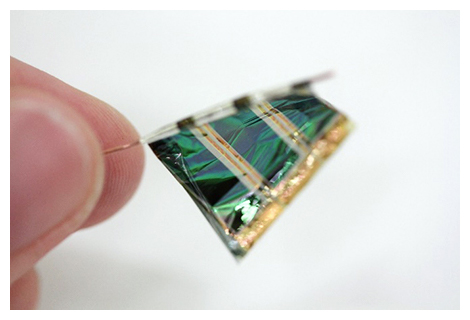Wearable devices have been increasingly popular in the past few years. Everything from smartwatches as a fashionable, convenient extension of one’s smartphone to thin bands for fitness tracking, wearable devices are rising in popularity. Such devices can add value to everyday life by providing a way to access information more readily. These electronic devices, however, are no help when they are dead. Minimizing charging frequency is important for all portable devices, but arguably even more so for wearable devices. If the goal is to always have a device readily available, extended battery life is essential. Therefore, some companies have created wearable devices that can be recharged using solar cells. This increases charge time potential while still being able to wear and operate the device as intended without inconveniencing the user.
Today's post is sponsored by DataRay - a leader in laser beam profiling solutions.
Basics of Solar Cells
The most common photovoltaic cells are silicon-based. Understanding semiconductor physics is critical to understanding the operation of solar cells. To create a solar cell, silicon layers will be doped to have more electrons, an n-type layer, in one (or some) layer(s) and others doped to have fewer, a p-type layer. P-type layers have an excess of holes–effectively locations where electrons are missing. These types of doped materials are configured so a p-type layer will be next to an n-type layer. The excess electrons and holes flow between the layers. This flow of charge carriers and creation of ions induce an internal electric field. Photovoltaic cells have this type of structure. When sunlight hits a photovoltaic cell, absorption of sunlight will excite electrons, creating holes in their place. The flow of the electrons creates electricity which can then be harnessed. Silicon solar cells generally have an efficiency hovering somewhere around 20 percent. The performance of solar cells is highly dependent upon the duration and intensity of the light they are exposed to.

Diagram depicting a breakdown of the basics behind a solar cell. Courtesy of Electronics Tutorials.
Solar Cells in Wearable Devices
While large solar panels installed on building roofs might be the first thing that comes to mind when talking about photovoltaic cells, they can be produced for much smaller applications. Garmin currently advertises a limited offering of solar-powered watches. These smartwatches have impressive battery lives. They list their Instinct Solar watches operating for 54 days on a single charge. Going off solar power alone and assuming 3 days outside at 50,000 lux, they claim unlimited battery life for their watch in battery saver mode. Both the watch’s screen and a photovoltaic ring around the screen can convert solar energy into electricity. Employing virtually the entire watch face for capturing solar power maximizes the charging power from the sun.
PowerWatch is a company that also uses solar power to recharge their watches. It is worth noting, however, that solar power is the secondary charging method. The primary charging method is not conventional either, but is achieved through a thermoelectric power sensor. Their MATRIX Prometheus sensor uses the thermal energy from the wearer’s body and converts it to an electrical output that powers the watch. This is a prime example of companies finding alternative methods for charging wearable devices.
Dawn of Solar-Powered Textiles
Not only are photovoltaic cells being developed for powering wearable electronic devices, but to be woven into everyday clothing. Nottingham Trent University’s School of Art and Design has a group which is researching how to create solar cells small enough to be laced into textiles. The group is attempting to combine solar cells into clothing in a way that is unnoticeable to the wearer. The goal is to create clothing that appears the same as all other clothing, only while simultaneously producing electricity. The material comprises of numerous solar cells integrated into the material measuring 3mm by 1.5 mm. The cells would be coated in resin to protect it from the wear and tear of regular usage and laundering. The photovoltaic cells would produce electricity which could be used to charge a device via a USB connection integrated into the clothing.
The group out of Nottingham is not the sole party interested in creating solar cells conducive to being part of daily fashion. Researchers at Rice University have been exploring flexible photovoltaic cells to be sewn into clothing or other wearable items. They see the flexibility of the solar cells as a critical achievement as traditional solar cells are far too rigid and brittle to be practical for clothing. Flexible solar cells are able to bend with the movement of the fabric without damage to the solar cell itself while maintaining the integrity of the garment. While their flexible cells are less efficient than conventional solar cells (a difference of roughly 7%), the flexibility could be well worth the deficit. The flexibility of the solar cells is achieved through using a material that is made up of “sulfur-based thiol-ene reagents”. The researchers have reported that cells with 20% thiol-ene content provide the prime combination of efficiency and flexibility.

One of the ultrathin, flexible solar cells. Courtesy of Riken.
Still other researchers have been creating flexible solar cells. Organic, ultrathin photovoltaic cells have been developed at the RIKEN research center in Japan. These solar cells were created by using an annealing process to improve the thin cell’s durability while retaining flexibility. Their solar cells have an energy conversion ratio of approximately 12%. Again, this is lower than the conventional silicon-based solar cell’s energy conversion ratio by about 10%. However, their research does show promising results with regards to the environments in which these ultrathin cells can be operational. They say that the solar cells are remain stable even under high temperatures and humidifies. This type of functionality and durability would indeed be beneficial for use in wearable devices.
Conclusion
Solar power and wearable technology are both evolving. While these two realms do not always overlap, the potential existing in areas where they do is extraordinary.
